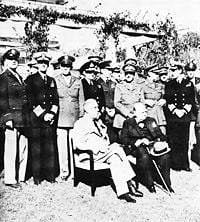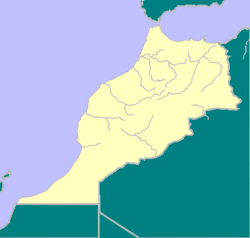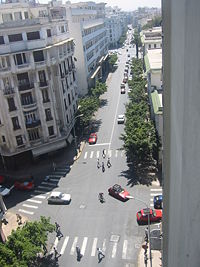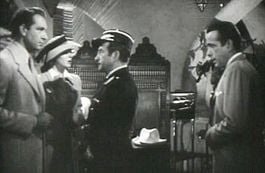Difference between revisions of "Casablanca" - New World Encyclopedia
Mary Anglin (talk | contribs) |
Mary Anglin (talk | contribs) m (→Transport) |
||
| Line 185: | Line 185: | ||
;Rail | ;Rail | ||
Casablanca is served by two rail stations run by the national rail service, the [[ONCF]]. The main long haul station is ''Casa-Voyageurs'', from which trains run south to [[Marrakech]] or [[El Jadida]] and north to [[Rabat]], and then on either to [[Tangier]] or [[Meknes]], [[Fes]], Taza and [[Oujda]]. A dedicated airport shuttle service to [[Mohammed V International Airport]] also has its primary in-city stop at this station, for connections on to further destinations. | Casablanca is served by two rail stations run by the national rail service, the [[ONCF]]. The main long haul station is ''Casa-Voyageurs'', from which trains run south to [[Marrakech]] or [[El Jadida]] and north to [[Rabat]], and then on either to [[Tangier]] or [[Meknes]], [[Fes]], Taza and [[Oujda]]. A dedicated airport shuttle service to [[Mohammed V International Airport]] also has its primary in-city stop at this station, for connections on to further destinations. | ||
| − | + | ||
The second station, ''Casa-Port'', serves primarily commuter trains running the Casablanca - [[Kenitra]] corridor, with some connecting trains running to Gare de Casa-Voyageurs | The second station, ''Casa-Port'', serves primarily commuter trains running the Casablanca - [[Kenitra]] corridor, with some connecting trains running to Gare de Casa-Voyageurs | ||
| + | [[Image:Principal Cast in Casablanca Trailer crop.jpg|right|thumb|265px|Principal cast of the movie, left to right: Victor Laszlo, Ilsa Lund, Captain Renault and Rick Blaine.]] | ||
== Casablanca in fiction == | == Casablanca in fiction == | ||
Revision as of 23:55, 9 June 2008
| Casablanca Anfa / الدار البيضاء Dar-el-Baida |
|
| Casablanca city center | |
| location of Casablanca in Morocco | |
| Coordinates: 33°32′N 7°35′W | |
|---|---|
| Country | Morocco |
| administrative region | Greater Casablanca |
| First settled | 7th century |
| reconstructed | 1756 |
| Government | |
| - Type | Monarchy |
| - ruler | Mohammed VI |
| - Major | Mohammed Sajid |
| Area | |
| - City | 324 km² (125.1 sq mi) |
| Population | |
| - City | 3.1 million (2,005 est.) |
| - Density | 9,132/km² (23,651.8/sq mi) |
| - Urban | 3.85 million (Grand Casablanca) |
| - Urban Density | 2,383/km² (6,171.9/sq mi) |
| Postal code | 20000-20200 |
| Website: http://www.casablanca.ma/ | |
Casablanca (Spanish for "whitehouse" {Casa = House, blanca = white} ; Amazigh: Anfa; Standard Arabic: الدار البيضاء; Moroccan Arabic: dar beïda) is a city in western Morocco, located on the Atlantic Ocean. It is the capital of the Greater Casablanca region.
With a population of 3.1 million (3.85 million in the "greater Casablanca" (September 2005 census, unofficially up to 6 million according to inhabitants), Casablanca is Morocco's largest city as well as its chief port. It's also the biggest city in the Maghreb and the sixth biggest city in the entire continent of Africa. With a majority of the modern economic sector being based in the Casablanca region, and the Casablanca area being dominant in industrial and service sector activity, it is often and justifiably referred to as the economic capital, although Morocco's political capital is Rabat. It is also the primary naval base for the Royal Moroccan Navy.
Casablanca is the leading city hosting headquarters and main industrial facilities for the leading Moroccan and international companies based in Morocco. Industrial statistics show Casablanca retains its historic position as the main industrial zone of the country. The Port of Casablanca is considered as Morocco's chief port and as one of the largest artificial ports in the world.[1] It is also the largest port of the Maghreb and North Africa.[2]
History
Pre-French Protectorate era
The area which is today Casablanca was settled by Berbers by at least the 7th century.[3] A small independent kingdom arose in the area then named Anfa in response to Arab Muslim rule, and continued until it was conquered by the Almoravids in 1068.
During the 14th century, while under the Merinids, Anfa rose in importance as a port. In the early 15th century, the town became an independent state once again, and emerged as a safe harbor for pirates and privateers, leading to it being targeted by the Portuguese, who destroyed the town in 1468.
The Portuguese used the ruins of Anfa to build a military fortress in 1515. The town that grew up around it was called "Casabranca," meaning "White House" in Portuguese. Between 1580 and 1640, the city was under Spanish rule, to be later transferred back to Portugal, who eventually abandoned the area completely in 1755 following near complete destruction by an earthquake.
The town was finally reconstructed by sultan Mohammed ben Abdallah (1756-1790), the grandson of Moulay Ismail and ally of George Washington. The town was called Dar el Beida (white house) in Arabic and Casa Blanca in Spanish.
In the 19th century, the area's population grew as Casablanca became a major supplier of wool to the booming textile industry in Britain and shipping traffic increased (the British, in return, began importing Morocco's now famous national drink, gunpowder tea). By the 1860s, there were around 5,000 residents, with the population increasing to approximately 10,000 by the late 1880s. [4] Casablanca remained a modestly-sized port, with a population reaching around 12,000 within a few years of the French conquest and arrival of French colonialists in the town, at first administrators within a sovereign sultanate, in 1906. By 1921, this was to rise to 110,000, [4] largely through the development of bidonvilles.
French rule

In June 1907, the French attempted to build a light railway near the port, passing through a graveyard. Residents attacked the French workers, and riots ensued. French troops were landed in order to restore order, which was achieved only after severe damage to the town. The French then took control of Casablanca. This effectively began the process of colonialization, although French control of Casablanca was not formalized until 1910. During the 1940s and 1950s, Casablanca was a major center of anti-French rioting.
The Casablanca Conference
Casablanca was an important strategic port during World War II and the site of a large American air base, which was the staging area for all American aircraft for the European Theater of Operations.
The city hosted the important Casablanca Conference in January 1943 in which Churchill and Roosevelt met to analyze the progress and discuss further strategy of the war. Soviet leader Joseph Stalin had been invited to attend, but declined. General Charles de Gaulle had initially refused to come but changed his mind when Churchill threatened to recognize Henri Giraud as head of the Free French Forces in his place. Giraud was also present at Casablanca, which reportedly caused notable tension.
The Conference produced the "Casablanca Declaration," which called for the Allies to seek the unconditional surrender of the Axis Powers. It also called for Allied aid to the Soviet Union in the invasion of Sicily and Italy, and the recognition of joint leadership of the Free French by de Gaulle and Giraud.
The Casablanca Conference was followed by the Cairo Conference, the Tehran Conference, the Yalta Conference and the Potsdam Conference.
Since independence
Morocco gained independence from France on March 2, 1956. Since that time Casablanca has become the economic and business capital of the nation, while Rabat is the political capital.
In March 2000, women's groups organized demonstrations in Casablanca proposing reforms to the legal status of women in the country. Forty thousand women attended, calling for a ban on polygamy and the introduction of divorce law (divorce being a purely religious procedure at that time). Although the counter-demonstration attracted half a million participants, the movement for change begun then was influential on King Mohammed VI, who enacted a new Mudawana, or family law, in early 2004, meeting some of the demands of women's rights activists.
On May 16, 2003, 33 civilians were killed and more than 100 people were injured when Casablanca was hit by a multiple suicide bomb attack carried out by Moroccans and claimed by some to have been linked to al-Qaeda.
A string of suicide bombings struck the city in early 2007. A suspected militant blew himself up at an internet cafe on March 11, 2007. On April 10, three suicide bombers blew themselves up during a police raid of their safe house. [5] Two days later, police set up barricades around the city and detained two more men who had escaped the raid. [6] On April 14, two brothers blew themselves up in downtown Casablanca, one near the American Consulate, and one a few blocks away near the American Language Center. Only one person was injured aside from the bombers, but the Consulate was closed for more than a month. [7]
Economy
The 1956 Moroccon independence brought several years of economic hardship for Casablanca, but the city soon revived through its focus on industry and commerce.
The Greater Casablanca region is considered the locomotive of the development of the Moroccan economy. It attracts 32 percent of the country’s production units and 56 percent of industrial labor. The region uses 30 percent of the national electricity production. With MAD 93 billion, the region contributes 44 percent of the nation's industrial production. Thirty-three 33 percent of national industrial exportations, MAD 27 billions, which is comparable with US $ 3.6 billion, come from Greater Casablanca. The majority of the nation's banking network is concentrated in the city.
One of the most important exports is phosphate. Other industries include fishing and fish canning, sawmilling, furniture making, building materials, glass, textiles, electronics, leather work, processed food, beer, spirits, soft drinks, and cigarettes.
Port of Casablanca
The Port of Casablanca refers to the collective facilities and terminals that conduct maritime trade functions in the city's harbors, and which handle Casablanca's shipping. The man-made port is protected from the sea by a breakwater. Not only does it handle the majority of Morocco's foreign trade, it is also a port of call for European ships. The boulevard leading to the port is lined with tourist shops. One of the largest artificial ports in the world. [8], it is also the largest port within the Maghreb and North Africa.
Casablanca's port treats a traffic of more than 21,3 million tons per annum, 38 percent of the national traffic, and carries out a sales turnover of more than 894 Million Moroccan Dirhams. With an extent of 605 hectares and extending to more than 8 kilometers in length. It can accommodate and treat more than 35 ships at once.
The port is located near Hassan II Mosque.
Cityscape
Approximately 12 percent of Morocco's population lives in the greater Casablanca region, which is also the largest urban area in the Maghreb. A 2005 census estimate listed the population at 3.85 million, though that figure is disputed by locals, who point to a number between 5 and 6 million, citing recent drought years as a reason for many people moving into the city to find work.
The area surrounding the Port is lined with tourist shops. Inland from the harbor is the original Arab town, known as the Old Medina. This area is partially enclosed by the original rampart walls, and is a maze of narrow streets and stone houses. It attracts fewer tourists than the medinas of other Moroccan towns, such as Fes and Marrakech. However, it has undergone some restoration in recent years. Included in this project have been the western walls of the medina, its skala, or bastion, and its colonial-period clock tower.
Built in a semicircle just outside these walls is the town built by the French, known as the French period New Town. Designed by the French architect Henri Prost, it a model of a new town at that time. The main streets of the New Town radiate south and east from Place des Nations Unies, where the main market of Anfa had been. The New Town is possibly the most impressive in Morocco. Former admistrative buildings and modern hotels populate the area. Their style is a combination of Hispano-Mauresque and Art Deco styles.
Landmarks
Casablanca is home to the Hassan II Mosque, designed by the French architect Michel Pinseau and built by Bouygues Construction. It is situated on a promontory looking out to the Atlantic, which can be seen through a gigantic glass floor with room for 25,000 worshippers. A further 80,000 can be accommodated in the mosque's courtyard. Its minaret is the world's tallest at 210 meters. It is the second largest mosque in the world (after the Masjid al-Haram in Mecca).
Work on the mosque was started in 1980, and was intended to be completed for the 60th birthday of the former Moroccan king, Hassan II, in 1989. However, the building was not inaugurated until 1993. Authorities spent an estimated $800 million in the construction of the building.
The Parc de la Ligue Arabe (formally called Lyautey) is the city's largest public park. On its edge is situated the Cathedrale du Sacré Coeur, which is no longer in use, but is a splendid example of Mauresque architecture.
- Hassan
- Morocco Africa Flickr Rosino December 2005 82664690.jpg
Hassan II Mosque
- Hassan II mosque2 (js).jpg
Minaret
- Hassan II mosque3 (js).jpg
Inside the Mosque
- Hassan II mosque4 (js).jpg
Inside the Mosque
- Hassan II mosque5 (js).jpg
Fountain
- Hassan II Mosque in the evening (js).jpg
Hassan II Mosque in the evening
- Morocco Africa Flickr Rosino December 2005 82664692.jpg
Interior of the Mosque
- Morocco Window.jpg
Looking out from the inside
Transport
- Air
Casablanca's main airport is Mohammed V International Airport, Morocco's busiest airport. Regular domestic flights serve Marrakech, Rabat, Agadir, Oujda, and Tangier, Laayoune as well as other cities.
Casablanca is well served by international flights to Europe, especially French and Spanish airports, and has regular connections to North American, Middle Eastern and sub-Saharan African destinations. New York, Dakar and Dubai are important primary destinations.
The older, smaller Casablanca Anfa airport to the west of the city which served certain destinations including Sydney, Damascus, and Tunis is scheduled closed to civilian traffic in 2006.
- Rail
Casablanca is served by two rail stations run by the national rail service, the ONCF. The main long haul station is Casa-Voyageurs, from which trains run south to Marrakech or El Jadida and north to Rabat, and then on either to Tangier or Meknes, Fes, Taza and Oujda. A dedicated airport shuttle service to Mohammed V International Airport also has its primary in-city stop at this station, for connections on to further destinations.
The second station, Casa-Port, serves primarily commuter trains running the Casablanca - Kenitra corridor, with some connecting trains running to Gare de Casa-Voyageurs
Casablanca in fiction
Casablanca was the setting of a 1942 film starring Humphrey Bogart (as Rick) and Ingrid Bergman as (Ilsa). Set in the Vichy-controlled city during World War II, its focus was on Rick's conflict between, in the words of one character, love and virtue: he must choose between his love for Ilsa and doing the right thing, helping her and her Resistance leader husband escape from Casablanca to continue his fight against the Nazis.
The film won three Oscars in 1943, including the Academy Award for Best Picture, and was nominated in five additional categories. The characters, quotations, and music have become iconic, and the film has grown in popularity as time has gone by. It now consistently ranks near the top of lists of the greatest films of all time, and has made Casablanca a household word.
Notes
- ↑ Casablanca - Encyclopedia of the Orient
- ↑ Discovering Casablanca - The Africa Travel Association
- ↑ Jewish Virtual Library. Casablanca Retrieved June 9, 2008.
- ↑ 4.0 4.1 C. R. Pennell. 2003. Morocco: from empire to independence. Oxford: Oneworld.
- ↑ Sky News. April 12, 2007. Terror Cell: 'Police Hold Fifth Man' Retrieved June 9, 2008.
- ↑ Independent News & Media. April 12, 2007. Casablanca on alert after suicide bombings Retrieved June 9, 2008.
- ↑ April 15, 2007. U.S. Shuts Morocco Consulate After Bomb
- ↑ Tore Kjeilen. Casablanca Encyclopedia of the Orient. Retrieved June 9, 2008.
ReferencesISBN links support NWE through referral fees
- Atkinson, Rick. 2002. An army at dawn the war in North Africa, 1942-1943. New York: Henry Holt & Co. ISBN 9780805062885
- Cahill, Marie. 1991. Casablanca. Hollywood classics. New York, N.Y.: Smithmark. ISBN 9780831745745
- Koch, Howard, and Julius J. Epstein. 1973. Casablanca; script and legend. Woodstock, N.Y.: Overlook Press. ISBN 0879510064 and ISBN 9780879510060
- Lukas, Scott A. 2007. The themed space: locating culture, nation, and self. Lanham, MD: Lexington Books. ISBN 0739121421 (Bahiyyih Maroon, “Leisure Space: Thematic Style and Cultural Exclusion in Casablanca,” pp. 137-151)
- Porch, Douglas. 1983. The conquest of Morocco. New York: Knopf. ISBN 0394511581 and ISBN 9780394511580
External Links
- Tore Kjeilen. Casablanca Time did go by. Lexicorient. Retrieved October 22, 2007.
- Morocco Travel. Tourist map. Retrieved October 22, 2007.
- Magic Morocco. Casablanca Morocco. Retrieved October 22, 2007.
Credits
New World Encyclopedia writers and editors rewrote and completed the Wikipedia article in accordance with New World Encyclopedia standards. This article abides by terms of the Creative Commons CC-by-sa 3.0 License (CC-by-sa), which may be used and disseminated with proper attribution. Credit is due under the terms of this license that can reference both the New World Encyclopedia contributors and the selfless volunteer contributors of the Wikimedia Foundation. To cite this article click here for a list of acceptable citing formats.The history of earlier contributions by wikipedians is accessible to researchers here:
- Casablanca history
- Casablanca_(film) history
- Casablanca_Conference history
- Port_of_Casablanca history
The history of this article since it was imported to New World Encyclopedia:
Note: Some restrictions may apply to use of individual images which are separately licensed.



